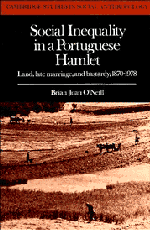Book contents
- Frontmatter
- Contents
- List of tables
- List of figures
- List of illustrations
- List of plates
- Acknowledgements
- 1 An ‘egalitarian’ Iberian community?
- 2 Open fields and communal land
- 3 Social groups
- 4 Cooperative labour
- 5 Matrimony and patrimony
- 6 Minimal marriage
- 7 The fulcrum of inheritance
- 8 Conclusion
- Appendix I The landholding survey
- Appendix II Social groups in 1851 and 1892
- Appendix III The Parish Register
- Appendix IV Household structure, 1977
- Appendix V Baptisms of bastards, 1870–1978
- Glossary of Portuguese terms
- Bibliography
- Index
- Cambridge Studies in Social Anthropology
Appendix I - The landholding survey
Published online by Cambridge University Press: 11 October 2009
- Frontmatter
- Contents
- List of tables
- List of figures
- List of illustrations
- List of plates
- Acknowledgements
- 1 An ‘egalitarian’ Iberian community?
- 2 Open fields and communal land
- 3 Social groups
- 4 Cooperative labour
- 5 Matrimony and patrimony
- 6 Minimal marriage
- 7 The fulcrum of inheritance
- 8 Conclusion
- Appendix I The landholding survey
- Appendix II Social groups in 1851 and 1892
- Appendix III The Parish Register
- Appendix IV Household structure, 1977
- Appendix V Baptisms of bastards, 1870–1978
- Glossary of Portuguese terms
- Bibliography
- Index
- Cambridge Studies in Social Anthropology
Summary
There is no codified Cadaster (Fr. cadastre) of the land owned in Fontelas either in Mosteiro or in the municipal town, or even in the offices of the Instituto Geográfico e Cadastral in Lisbon. The latter body has hanging inside the entrance to its Lisbon office a large map of Portugal which divides the country into two Southern and Northern halves. The completion of a new land-tax register (cadastro) is still in progress at the national level but has only reached the Central region of Portugal, having started in the South and proceeding Northwards. While Cutileiro's calculation of the distribution of land in Vila Velha (1971:41–4) was in part based upon the Instituto's cadastral maps of the South (personal communication) no such maps were available for the North.
The Tax Bureau in town does however have an entire room filled with a series of books which are together termed not a Cadaster but matrizes (land registers). These registers consist of listings of all of the parcels of land within each named area of each of the municipality's 95 hamlets. All of the parcels in each area of one hamlet, for example, are listed along with the names of their owners and an estimate of their area in ‘ploughing days’ (jeiras) or fractions of a day needed to plough the parcel. One full ploughing day is equivalent in this region to about 0.3 hectare. In surface area this would be about 3.3 ares, or 3,300 square metres.
- Type
- Chapter
- Information
- Social Inequality in a Portuguese HamletLand, Late Marriage, and Bastardy, 1870–1978, pp. 350 - 354Publisher: Cambridge University PressPrint publication year: 1987



